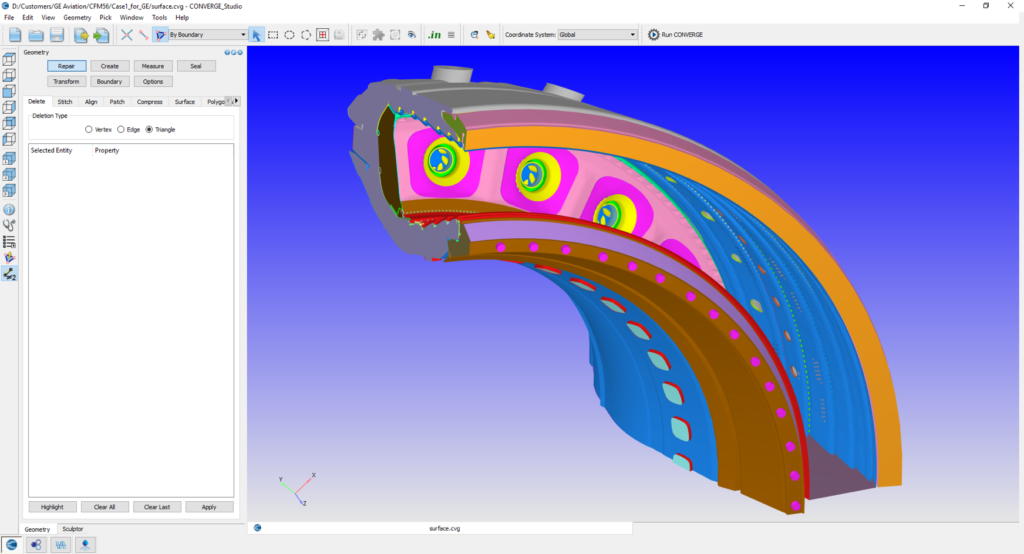Gas turbine manufacturers routinely use computational fluid dynamics (CFD) to improve engine performance and reliability. In order for a CFD software to provide insight during the design process, though, it must deliver accurate results within a timeframe that meets rapid design schedules. One application in which traditional simulation approaches have struggled is the design of the gas turbine ignition system. Absent a reliable simulation approach, designers have relied on expensive experimental testing for gas turbine ignitors. At best, this approach yields incremental improvements, and it may fail to identify the optimal solution.
Designing the optimal gas turbine ignition system is a difficult problem involving complex physical processes. Jet fuel atomization, spray transport, and evaporation must be controlled to provide precisely the right fuel/air ratio near the ignitor such that the electric spark creates a small kernel of flame. That flame kernel must then be transported into the dome of the combustor to ignite one of the fuel sprays. The flame must then propagate around the combustor to ignite all of the remaining fuel sprays. In addition to this multi-step physical process, the ignitor must be reliable not only on the ground but also at high altitude relight conditions. Clearly, to model gas turbine ignition, a CFD software must be able to incorporate sophisticated geometries and complex fluid dynamics, fuel sprays, evaporation, combustion, heat transfer, and kinetics—all while maintaining reasonable computational costs.
Historically, CFD has not been able to model gas turbine relight accurately or quickly enough to provide useful engineering insight. Historical CFD approaches for aircraft relight have been hampered by difficulties in meshing the complicated combustor topology, excessive simulation runtimes, and overall lack of simulation accuracy. The lack of accuracy stems in part from the fact that the most frequently used combustion models, such as the Flamelet Generated Manifold model, simplify the combustion process so much that they do not accurately capture the transient, kinetically limited reactions associated with ignition. As a result, CFD engineers previously have tuned the combustion, spray, and turbulence models in order to match experimental data. Unfortunately these postdictive approaches are not predictive when applied to different combustor designs or operating conditions.
Beyond the challenges of accurately modeling ignition and relight, traditional CFD approaches require a computational mesh to be manually generated prior to simulation. This time-consuming process often is a major bottleneck in the CFD workflow. Traditional meshing approaches also do not allow mesh refinement when and where resolution is most needed. In other words, the CFD analyst must to know the answer a priori in order to generate an optimal mesh in terms of accuracy and cell count.
CONVERGE CFD was designed to accurately and rapidly model turbulent, reacting multiphase flows. CONVERGE automatically makes a mesh at runtime and thus eliminates all user meshing time. In addition, CONVERGE’s Adaptive Mesh Refinement (AMR) feature refines the mesh in regions with large gradients of temperature and velocity, such as the ignitor spark region and the flame surface in a gas turbine simulation. In ignition cases, AMR is especially useful because the cell count can be kept low at the start of the simulation (when the kernel is small) and increased only as it becomes important to refine the propagating flame front.
CONVERGE includes a fully coupled detailed chemistry solver that can accommodate any reaction mechanism (i.e., there are no restrictions on the number of species or reactions) and a rich set of spray models that can accurately consider the atomization, transport, and evaporation of complex jet fuels. CONVERGE allows ignition to be modeled directly with proper definitions of spark duration, shape, temperature, and energy. Engineers at Convergent Science have previously demonstrated CONVERGE’s accuracy in predicting ignition and flame propagation changes with geometry and operating conditions in both gaseous and liquid fuel validation experimental cases[1]. Furthermore, aircraft manufacturers have documented the benefits of CONVERGE for modeling gas turbine relight simulations[2].

GEAE wanted to determine if CONVERGE could accurately predict the ignition performance of one of their most successful engines, the CFM-56, for three operating conditions (OC):
Convergent Science engineers, who did not know in advance the outcome of each OC, simulated the three OCs to determine their ignition and flame propagation characteristics.
The computational domain considered five injectors, a single ignitor and all the effusion cooling holes. Each simulation invoked Large Eddy Simulation (LES) turbulence modeling, CONVERGE’s detailed chemistry solver, and state-of-the-art spray and evaporation models. CONVERGE’s autonomous meshing easily created a high-quality mesh for the complex combustor, ignitor, and cooling geometries, and refined the mesh in key areas to maximize accuracy while minimizing runtime. As shown below, CONVERGE was able to accurately predict the ignition and flame propagation for all three operating conditions.
Detail of flame kernel temperature and AMR for CFM-56 combustor.
OC-1 allowed for complete relight: a stable ignition kernel was produced, which rapidly propagated to ignite all of the fuel sprays. The ignition and flame propagation for this case is shown below.
OC-2 resulted in partial relight: a flame kernel ignited the local fuel spray and propagated to its neighboring atomizer. However, the flame propagation stopped midway across the combustor (i.e., not all of the atomizers were ignited). The ignition and flame propagation for OC-2 is shown in the following movie.
Flame iso-surface for OC-1 (complete relight) and OC-2 (partial relight) cases. Droplets are colored by the atomizer from which they originated.
OC-3 failed to relight as the flame kernel extinguished before igniting any of the fuel sprays.
The development of the ignition kernel and flame propagation for OC-1 and OC-2 are shown in the images below.
Close-up of flame kernel for OC-1 (successful relight), OC-2 (partial relight) and OC-3 (failed relight) cases.
GEAE engineers are now testing CONVERGE on fundamental and practical combustor designs for further validation, development of best practices, and optimization. Given this is a new area of CFD application for GEAE and other manufacturers, new processes and integration into the design flow are being investigated.